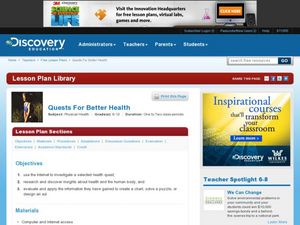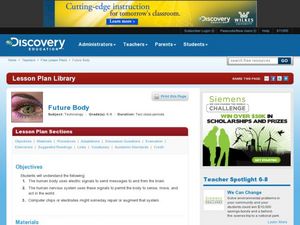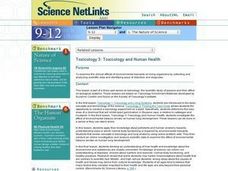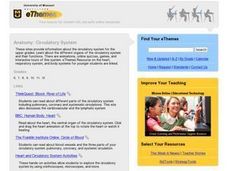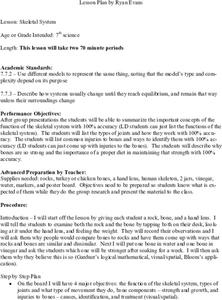Curated OER
Quests for Better Health
Pupils use the Internet to investigate a health quest that is assigned to them. In this investigative lesson students research insights about the human body, evaluate and apply the information to create a chart, puzzle or design an...
Curated OER
Human Skeletal System
Learners trace the outline of one of their members and draw in the bones from the diagram. They make flashcards of the bones out of index cards. Once the drawings and flashcards are finished, they quiz each other in preparation for a game.
Curated OER
Regents High School Exam: Living Environment 2008
Tne New York Regents High School Examinations are comprehensive and include various styles of questions, includingmultiple choice and the analysis of graphs. This particular version, the 2008 Living Environment exam surveys a variety of...
Curated OER
Regents High School Examination: Living Environment 2005
The 2005 version of the Regents High School Examination in the area of ecology is as comprehensive as previous years' exams. It consists of 40 multiple choice questions on everything from the structure of DNA to the interactions within...
Curated OER
Regents High School Examination: Living Environment 2003
The living environment, from the interior of a cell to the complex relationships among populations, are queried in this final examination. Learners look at air pollution maps, diagrams of cells, population graphs, and drawing of cells....
Kenan
Respiratory System
Explore the respiratory system with a model. First, pupils build a set of lungs to experiment how they inflate and deflate. Then, they delve deeper into the topic with a web quest to discover new information about the nose, trachea, and...
Curated OER
Future Body
Young scholars explain the benefits of cyborg augmentation. In this technology lesson plan, students research how the nervous system works. They create posters and present them to class.
Curated OER
Toxicology And Human Health
Students examine the clinical effects of environmental toxicants on living organisms by collecting and analyzing scientific data and identifying ways of detection and diagnosis.
Curated OER
Natural Born Robots: Body Builders
Learners perform activities to explore how their arm works and what muscles are involved. They view animated comparisons of human and robotic arms. Students create a model of the human arm.
Curated OER
How Does the Cardiovascular System Work?
Students explore the basic anatomy and functions of the cardiovascular system. They identify parts of the cardiovascular system according to the levels of organization. In addition, they trace the path of a blood cell through the...
Curated OER
Where is Your Heart? What Does it Do?
Students identify size and general location of human heart, identify heart muscle, describe, in general terms, heart's basic function of pumping blood throughout body, and complete "Where is Your Heart" and "What Does My Heart Look...
Curated OER
Smart Ideas Lesson Plan
Seventh graders create a concept map about the cardiovascular system. In this life science lesson, 7th graders identify the parts and functions of each system component. They explain how cardiovascular system works with other systems in...
Teach Engineering
Skin and the Effects of Ultraviolet Radiation
Though UV radiation can damage skin, it isn't all bad. The third installment in a six-part series allows the class to study the structure and function of skin. They learn about the different types of skin cancer and the SPF rating...
Curated OER
Body Voyager
Students explore the significance of a resting and an active heart rate. In this heart lesson students chart data on their pulse and draw a diagram of the heart.
Curated OER
Excretory System
Learners discuss what happens to the trash in their home. They talk about what would happen if they didn't remove the trash. Students relate their home trash to the excretory system of their bodies. They label a diagram of the urinary...
Curated OER
Circulatory System Design
Students identify the different parts of the circulatory system and their function. They work together to create their own model of the system and use it to determine the rate of blood flow. They answer questions related to their model.
Curated OER
The Strength of the Muscular System
Seventh graders investigate the strength of the muscular system. They explore voluntary and involuntary muscle movement and discuss the types of muscles: cardiac or heart, skeletal, and smooth. They visit stations to answer questions...
Curated OER
Anatomy: Circulatory System
Young scholars use the Internet to research the circulatory system. They explore the different organs of the circulatory system and their functions. There are animations, online quizzes, games, and interactive tours of this system.
Curated OER
Human Traces
Students create and construct human skeletons by rubbing casts of bone impressions on paper, and then label most important components of human skeleton.
Curated OER
The Human Organism
Seventh graders examine the basic functions of the human body and see how changing demands affect our bodies. In this human organism lesson students participate in several activities that are about the human body and our digestion,...
Curated OER
Skeletal System
Students identify the components and functions of the skeletal system. They identify and interpret that the skeletal system is the frame for the human body and are evaluated by their behavior and participation throughout the...
Curated OER
Skeletal System
Seventh graders explore the functions of the skeletal system. They collaborate in small groups to determine the function of the skeletal system, the types of joints and movement, bone strength and growth, and bone injuries including...
Curated OER
Internal Anatomy: A Fun Look At The Digestive System
Young scholars look at the functions of the body. In this biology lesson plan, students explore the functioning of some body part and construct a "living doll" composed of the body parts discussed.
Curated OER
Central Nervous System Study Questions
In this central nervous system worksheet, learners define 24 terms associated with the human central nervous system. They answer 28 short answer questions dealing with the structures and function of the CNS.
